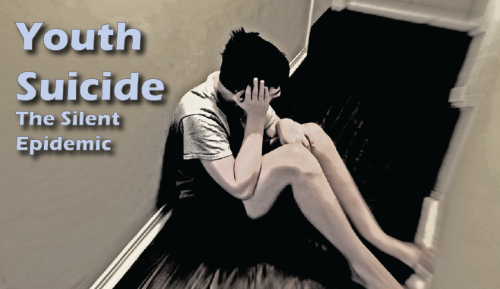Context-
Suicide among young people in India is a pressing public health concern, marked by alarming statistics and complex contributing factors. Experts shed light on this issue, highlighting its multifaceted nature and the urgent need for comprehensive strategies to address it effectively.
The Scale of the Problem
The statistics surrounding youth suicide in India are staggering, reflecting a profound societal challenge. According to the National Crime Records Bureau (NCRB), the country witnessed 1.71 lakh suicides in 2022 alone, with a suicide rate of 12.4 per 1,00,000—the highest ever recorded. Shockingly, 41% of these suicides occur among individuals under the age of 30, making suicide the leading cause of mortality for young women in India. This grim reality underscores the urgent need for targeted interventions to prevent further loss of young lives.
Contributing Factors
Understanding the diverse factors contributing to youth suicide is crucial for developing effective prevention strategies.
● Mental Health Challenges
A significant proportion of adolescent suicides in India—54%—are linked to underlying mental health issues, such as depression and anxiety. The prevalence of mental health disorders among young people highlights the critical need for improved mental health support and early intervention strategies tailored to the unique needs of this demographic.
● Negative Family Dynamics
Traumatic family issues play a substantial role in youth suicide, with 36% of cases citing family-related stressors such as conflicts, abuse, or neglect. Addressing family dynamics and providing family-based interventions are crucial components of suicide prevention efforts, aiming to create supportive and nurturing family environments.
● Academic Pressure
India's education system, characterized by intense academic competition and pressure to excel, is a key driver of youth suicide. Academic stress, coupled with the fear of failure, disproportionately affects young individuals. In 2022, examination failure drove over 2,000 people to suicide, highlighting the urgent need for systemic reforms to alleviate this burden and promote holistic student development.
● Social and Lifestyle Factors
Social factors such as violence (22%), economic distress (9.1%), and discrimination significantly contribute to the vulnerability of young people to suicidal behavior. Addressing these societal challenges requires concerted efforts at multiple levels, including economic support programs and initiatives to combat social stigma and discrimination.
● Cyberbullying and Social Media
The proliferation of cyberbullying and excessive social media use has been linked to heightened suicide risks among adolescents. A meta-analysis revealed that one-third of cyberbullied individuals contemplate suicide, highlighting the need for digital literacy programs and mental health support tailored to address modern influences on youth mental health
Gender Dynamics
Distinct socio-cultural factors impact suicide rates among young girls and women in India, necessitating targeted interventions to address gender-specific vulnerabilities.
● Arranged Marriages and Early Motherhood
The prevalence of arranged marriages and early motherhood exposes young women to heightened stress and social pressures, increasing their susceptibility to suicidal ideation. In India, young women facing early marriages and motherhood are at increased risk, with suicide being the leading cause of mortality among young females.
● Gender Roles and Discrimination
Rigid gender roles and discriminatory practices further exacerbate the vulnerability of young women to mental health challenges and suicidal behavior. Efforts to promote gender equality and challenge harmful stereotypes are essential for preventing suicides among young women.
Preventive Strategies and Interventions
Despite the complexity of youth suicide, preventive strategies and interventions offer hope for reducing its prevalence and impact.
● Enhancing Mental Health Literacy
Empowering young people with problem-solving skills, emotional regulation techniques, and improved help-seeking behaviors can significantly reduce suicide rates. Early identification of mental health distress and accessible care are vital components of effective prevention, supported by initiatives like youth-friendly mental health services.
● Family and Community Support
Improving family environments by reducing domestic violence and promoting positive parenting practices can create protective buffers against suicidal behavior among young individuals. Community-based programs that foster resilience and social connections also play a critical role in suicide prevention.
● Educational Reforms
Reforms in the education sector, including alternative assessment methods and holistic approaches to student development, are crucial in reducing academic-related stressors that contribute to youth suicides. Comprehensive educational reforms aim to create supportive learning environments that prioritize student well-being over academic achievement.
National Suicide Prevention Strategy
The launch of India's National Suicide Prevention Strategy in 2022 represents a significant milestone in addressing this critical issue.
● Intersectoral Collaboration
The strategy underscores the importance of intersectoral collaboration among health, education, and social welfare ministries to implement comprehensive suicide prevention initiatives. Collaborative efforts leverage resources and expertise across sectors to create a unified approach to suicide prevention.
● Youth Engagement and Awareness
Engaging educational institutions and youth organizations in promoting mental health and reducing behavioral addictions through targeted programs is a cornerstone of the national strategy. Youth engagement initiatives empower young individuals to become advocates for mental health and support systems within their communities.
Conclusion
Youth suicide in India demands urgent and multifaceted responses that address its complex determinants and mitigate its devastating impact on individuals and communities. By implementing evidence-based strategies, fostering collaboration across sectors, and prioritizing mental health support, India can aspire to a future where no young life is lost to suicide due to inaction or neglect. Comprehensive interventions that address societal challenges, promote mental health literacy, and empower young individuals are key to preventing youth suicide and fostering a culture of well-being and resilience.
|
Probable Questions for UPSC Mains Exam- 1. Discuss the major contributing factors to youth suicide in India based on the data presented by the National Crime Records Bureau (NCRB) in 2022. How do mental health challenges, family dynamics, academic pressure, and societal factors interact to increase vulnerability among young individuals? ( 10 Marks, 150 Words) 2. Evaluate the effectiveness of the National Suicide Prevention Strategy launched in India in 2022. What are the key components of this strategy, and how does it aim to address the complex determinants of youth suicide? Discuss the importance of intersectoral collaboration and community engagement in implementing comprehensive suicide prevention initiatives.( 15 Marks, 250 Words) |
Source- The Hindu







